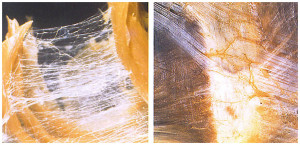The Fascination with Fascia

In the process of our evolution as individual humans, we shift our thinking about our bodies and our somatic, kinesthetic experience of the world (aka. “getting older”). Sometimes our perception shifts occur naturally and easily and sometimes only with planned and focused effort.
Structural Integration (SI) is one method of delving into, exploring and evolving our conversation with and about our bodies. While I believe that SI is extraordinarily far reaching in it’s ability to shift the patterns of our lives beyond our physical form, much of the focus of the work is centered specifically on working with the body’s fascial system.
Considering that this is the case, I believe that it is useful to be clear about one thing. When it comes to fascia…. We. Don’t. Know. A Lot. And seriously, how awesome is that?
It is truly striking that in the world of medical and anatomical research, fascia is a relatively new area of study. This article (How a Mysterious Body Part Called Fascia Is Challenging Medicine) does an excellent job of discussing the intense interest on the part of Complimentary and Alternative Medicine (CAM) practitioners (including bodyworkers like myself) and our strange and awkward journey along with fascia researchers toward a deeper understanding of this long overlooked system and the role it may (or may not) play in manual therapies like Structural Integration. Fundamentally, the world of hard, replicable science is often at odds with the dynamic, individual and intuitive approach that lends itself to bodywork and manual therapy. The ability to “prove” and therefore more clearly define and articulate what it is that we are doing when we place our hands on a body and seek to create shifts in the fascial network is a primary concern.
September 2015 will be marked by the Fourth International Fascia Research Congress and a continuing conversation between researchers and clinicians regarding the latest findings about fascia. I look forward to learning about new discoveries in the world of fascia and exploring new hypothesis regarding its role in our lives. The road ahead will be very interesting and I for one am excited to find out where it will lead!
In the mean time, as we explore newfound freedoms (or old limitations) within our bodies, we can look to fascia for a better understanding of the interconnected nature of the human system. For those of you who have not yet seen this excellent article from Runner’s World, it offers a straightforward and concise overview of what fascia is and why we should care.
I welcome your questions and comments!
~A
